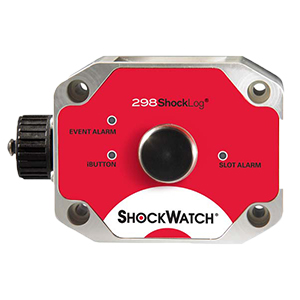The ShockLog® 298 data logger monitors and records indicators such as impacts, shocks, vibrations, and environmental conditions while transporting or storing goods. The logger features a real-time alert system, promptly notifying users of the potential effects to ensure immediate inspection.
Comprehensive Programming Control
The key features of the logger include customisable impact scales and frequency filters, with the ability to display peak values in time slots and summarised journey profile data. It can record impact curves of up to 870 events and 262,000 slots, capturing essential information such as the amplitude, direction and duration of impact force and peak acceleration values over time.
The logger allows easy setup, downloading, and data access through a USB connection or iButton® interface. The iButton® interface ensures a secure and tamper-proof journey report download. The ShockLog® software, compatible with Windows®, provides complete programming control and full access to the recorded data.
Using the ShockLog® 298, users can establish baseline damage boundaries, identify mishandled goods, and assign accountability throughout the operation, shipping, and storage processes. The data analysis capabilities of the logger help identify areas for review in product packaging, loading procedures, carriers, and transportation methods, ultimately leading to cost reductions.
Versatile Sensor Integration: Expanding Capabilities
- Measures X, Y, and Z-axis, impacts for equipment safety
- Captures vibrations during use and transport
- Provides data on equipment positioning
- Stores up to 870 events and 262,000 time slots
- Notifies users of potential impact damage
- Easily transfers data to ShockLog software via USB or iButton®
- Offers real-time notifications and location data
- Expand monitoring capabilities with add-on sensors
- Long-lasting operation with user-programmable settings
- No need for cables or wires during operation
- Field-proven triaxial piezoelectric accelerometer technology
- IP67-rated and RF-screened
- Programmable wake-up values to maximise battery life up to 18 months.
- Option to place temperature/humidity sensor into the unit or add a temperature/pressure/ humidity accessory sensor
- Option to capture coordinates when an event occurs at summary intervals with GPS
- Option to include the use of Google Maps and hyperlinks with GPS to pinpoint location of event
- Operating Temperature Range: -22°F to to 185°F / -40°C to 85°C
- Size: 4.8in x 3.1in x 2.2in / 123mm x 84mm x 55mm
- Weight: 1.1lbs / 515g (without battery)
- Battery: 2 x 3.6V lithium / 2 x 1.5V alkaline size AA
- Battery Life: Up to 18 months with lithium battery
- Scale Factor: ± 2%
- Additional Error Other Ranges: ± 2%
- Acceleration Range: ± 1 to ± 200G
- Cut-off Frequency Options (Programmable): 10Hz, 40Hz, 50Hz, 90Hz, 120Hz, and 250Hz
- Wake-up, Warning, and Alarm Threshold (% of Range): 5–95%
- Wake-up Time: 0.25ms
- External Power Source Option: 4.5V min / 30V max
- Software Compatibility: Windows 10, 8, 7, Vista, XP
shocklog®-298-product-brochure: Download


